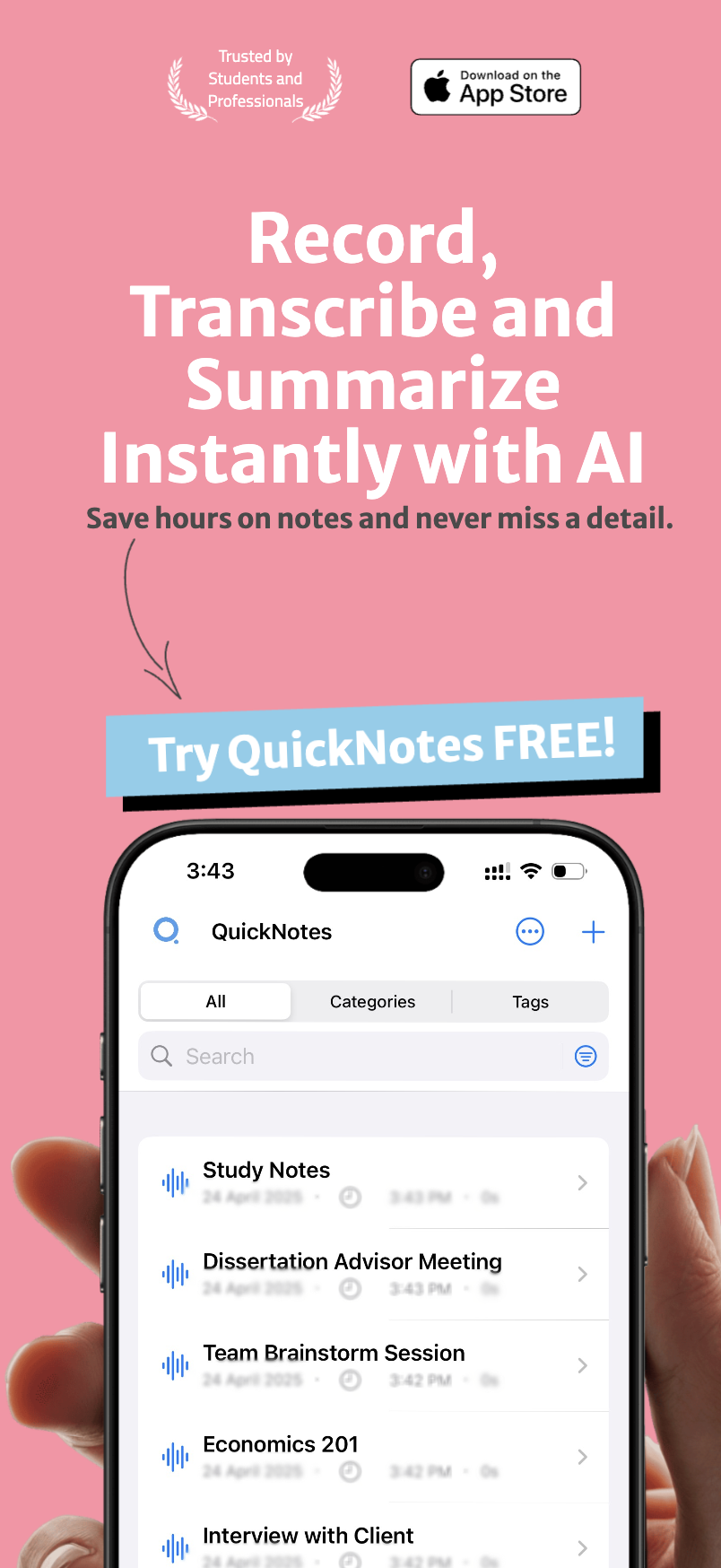The true value of capturing information lies not just in recording it, but in being able to retrieve exactly what you need when you need it. As your collection of notes, recordings, and transcriptions grows, the ability to quickly find specific content becomes increasingly critical.
Table of Contents
- Beyond Basic Search: QuickNotes' Comprehensive Search Capabilities
- Full-Text Transcription Search
- Advanced Query Syntax
- Contextual Results
- Multi-Criteria Filtering: Narrowing Down Results
- Metadata Filtering
- Organizational Filtering
- Content-Based Filtering
- Combined Filtering
- Search Techniques for Different Scenarios
- Finding Specific Facts or Quotes
- Researching a Topic Across Multiple Notes
- Finding Action Items or Commitments
- Locating Information from a Specific Meeting
- Power User Search Features
- Semantic Search
- Search Within Results
- Advanced Audio Search
- Optimizing Your Content for Searchability
- Recording Best Practices
- Organizational Tactics
- Post-Processing Enhancements
- Search Shortcuts and Time-Saving Tips
- Keyboard Shortcuts
- Voice Search Commands
- Result Management
- Real-World Search Scenarios
- For Students
- For Business Professionals
- For Researchers
- Conclusion: From Information Overload to Instant Access
- You Might Also Like
QuickNotes' advanced search and filtering capabilities were designed to solve this challenge, providing powerful tools that help you pinpoint exactly what you're looking for in seconds. In this article, we'll explore how to master these features to make the most of your growing knowledge base.
Beyond Basic Search: QuickNotes' Comprehensive Search Capabilities#
Most note-taking apps offer simple keyword search, but QuickNotes goes far beyond the basics with a sophisticated search engine designed specifically for speech-to-text content:
Full-Text Transcription Search#
- Search across every word in all your transcribed recordings
- Find mentions even in the middle of long conversations or lectures
- Locate approximate matches even when transcription isn't perfect
- Search within specific notes or across your entire library
Advanced Query Syntax#
- Use quotation marks for exact phrase matching
- Employ Boolean operators (AND, OR, NOT) for complex queries
- Add wildcards for partial matching
- Create proximity searches to find terms near each other
Contextual Results#
- View search hits with surrounding context for better relevance judgment
- Jump directly to the exact point in audio recordings where matches occur
- See highlighted matches in transcription view
- Quickly navigate between multiple matches within a single note
"The ability to search across all my lecture recordings and instantly jump to the exact moment where a concept was discussed has completely transformed my study process. What used to take hours of re-listening now takes seconds." — Sophia C., Medical Student
Multi-Criteria Filtering: Narrowing Down Results#
Beyond text search, QuickNotes offers robust filtering capabilities that let you narrow results based on multiple criteria:
Metadata Filtering#
- Filter by date ranges (created, modified, accessed)
- Filter by recording duration or word count
- Filter by file format or quality settings
- Filter by device used for recording
Organizational Filtering#
- Filter by categories and folders
- Filter by single or multiple tags
- Filter by sharing status (private, shared, public)
- Filter by favorites or recently accessed
Content-Based Filtering#
- Filter by detected speakers
- Filter by identified topics or themes
- Filter by sentiment (positive, negative, neutral)
- Filter by content type (questions, action items, definitions)
Combined Filtering#
- Apply multiple filters simultaneously for precise results
- Save frequently used filter combinations as presets
- Create smart collections based on filter criteria
- Share filtered views with collaborators
Search Techniques for Different Scenarios#
Different search needs call for different approaches. Here's how to optimize your search strategy based on what you're looking for:
Finding Specific Facts or Quotes#
Best Approach: Exact phrase search with contextual preview
- Use quotation marks around the exact wording you remember
- If unsure of exact wording, try keyword proximity search
- Review context snippets to identify the right match
- Use the "Jump to Audio" feature to hear the original statement
Researching a Topic Across Multiple Notes#
Best Approach: Keyword search with tag and date filtering
- Start with broad topic keywords
- Add relevant tags to narrow the focus
- Consider date filtering if the topic evolved over time
- Use the "Related Content" feature to discover connected notes
Finding Action Items or Commitments#
Best Approach: Content type filtering with recency sorting
- Filter for automatically detected action items
- Sort by date to prioritize recent commitments
- Use keyword search for specific projects or people
- Save the search as a smart collection for ongoing reference
Locating Information from a Specific Meeting#
Best Approach: Combined metadata and content filtering
- Filter by date range when the meeting occurred
- Add participant names or meeting title keywords
- Filter by folder or category if you organize by project
- Sort results by relevance to find the most significant matches
Power User Search Features#
For those who want to take their search capabilities to the next level, QuickNotes offers several advanced features:
Semantic Search#
- Find content based on meaning rather than exact keywords
- Discover related concepts even when specific terms aren't mentioned
- Use natural language questions to find relevant information
- Leverage AI to understand the context of your search query
Search Within Results#
- Progressively narrow search results with additional criteria
- Apply secondary keywords to initial search results
- Refine large result sets through iterative filtering
- Navigate complex information hierarchies efficiently
- Save complex search queries for repeated use
- Create dynamic smart collections that update as new content matches
- Set up alerts for when new content matches important search criteria
- Schedule regular search reports for ongoing research
Advanced Audio Search#
- Search by speaker identity across multiple recordings
- Find specific audio characteristics (pauses, emphasis, questions)
- Locate similar audio patterns even without transcription
- Search within specific timeframes of longer recordings
Optimizing Your Content for Searchability#
You can enhance the effectiveness of QuickNotes' search capabilities by optimizing how you capture and organize your content:
Recording Best Practices#
- Start recordings with clear topic statements for better context detection
- Mention key terms explicitly during important discussions
- Spell out names, technical terms, or unusual words when first mentioned
- Use clear speech patterns for optimal transcription accuracy
Organizational Tactics#
- Apply consistent, specific tags to improve filtering relevance
- Add custom metadata for important contextual information
- Use descriptive titles that include key content indicators
- Establish consistent naming conventions for recurring content
Post-Processing Enhancements#
- Review and correct transcription of key terms and names
- Add notes or annotations to highlight important sections
- Create custom vocabularies for specialized terminology
- Mark sections with timestamp comments for easier navigation
Search Shortcuts and Time-Saving Tips#
Save time and increase efficiency with these practical search tips:
Keyboard Shortcuts#
- Press Ctrl+F (Cmd+F on Mac) anywhere in the app for global search
- Use Tab to navigate between search results
- Press Ctrl+S (Cmd+S) while viewing search results to save the search
- Use arrow keys to quickly navigate result previews
Voice Search Commands#
- Activate voice search with "Hey QuickNotes, find..."
- Use natural language commands like "Show me notes about project X from last week"
- Combine voice commands with filters: "Find mentions of budget in marketing meetings"
- Create voice shortcuts for common searches
Result Management#
- Use the "Export Results" feature to compile findings into a single document
- Create a new note directly from search results with key findings
- Share specific search results with team members
- Sort results by relevance, date, or custom criteria
Real-World Search Scenarios#
Let's look at how QuickNotes' search capabilities solve real-world challenges:
For Students#
Scenario: Preparing for finals by finding all mentions of a complex concept across a semester of lecture recordings
Solution:
- Use semantic search to find mentions of the concept, even when exact terminology varies
- Filter by course-specific tags to focus on relevant lectures
- Export search results to create a focused study guide
- Save the search to revisit as new questions arise during study
For Business Professionals#
Scenario: Locating all client commitments made during the past month across multiple meeting recordings
Solution:
- Filter by "Action Items" content type
- Add date range filter for the past month
- Apply client name as a keyword filter
- Sort by due date to prioritize immediate commitments
For Researchers#
Scenario: Finding patterns across dozens of interview transcriptions
Solution:
- Use theme detection to identify common topics across interviews
- Create saved searches for each research question
- Apply demographic filters to compare responses across different groups
- Export contextual snippets to include in research findings
Conclusion: From Information Overload to Instant Access#
As your digital knowledge base grows, the ability to find exactly what you need becomes as important as capturing the information in the first place. QuickNotes' advanced search and filtering capabilities transform what could be an overwhelming volume of content into an instantly accessible resource.
By mastering these powerful search tools—from full-text transcription search to multi-criteria filtering, semantic search, and saved queries—you'll never lose valuable information in the digital depths again. Instead, you'll develop the confidence that comes from knowing any piece of information you've captured is just seconds away when you need it.
In a world of information overload, this kind of instant, precise access isn't just convenient—it's transformative for productivity, learning, and decision-making. With QuickNotes' advanced search capabilities, the answer to "Where did I put that information?" is always right at your fingertips.
You Might Also Like#

AI-Powered Summarization: Extract Key Insights Instantly
Learn how QuickNotes' AI summarization technology helps you extract key insights from lengthy recordings and transcriptions, saving time and improving information retention.

Organization and Tagging: A System for Effective Information Management
Learn how QuickNotes' powerful organization and tagging system helps you categorize, find, and utilize your notes and recordings effectively.

Multi-Language Transcription: Breaking Down Communication Barriers
Discover how QuickNotes' multi-language transcription capabilities can break down communication barriers and streamline global collaboration.

